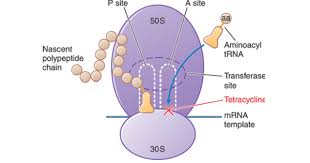Chloramphenicol is a lipophlic drug , orally absorbed and can be given by parenteral
routes . It is widely distributed throughout the body and penetrate to CSF. It is conjugated
in liver to inactive glucuronide, about 10% of the total dose administered, and its inactive
products are eliminated in the urine. Dose reductions are necessary in patients with liver
dysfunction or cirrhosis. It is also secreted into breast milk and should be avoided in
breast feeding mothers.
Clinical uses:
Because of its toxicity, it only may be considered for treatment of serious rickettsial
infections such as typhus and Rocky Mountain spotted fever. It is an alternative to a β-
lactam antibiotic for treatment of bacterial meningitis occurring in patients who have
major hypersensitivity reactions to penicillin.
Adverse effects:
1- Anemias: Patients may experience dose-related anemia, hemolytic anemia e.g; in
patients with G-6- PD deficiency, and aplastic anemia.
2- Gray baby syndrome: Neonates have a low capacity to glucuronidate the antibiotic,
and they have underdeveloped renal function. Therefore, neonates have a decreased
ability to excrete the drug, which accumulates to levels that interfere with the function of
mitochondrial ribosomes. This leads to poor feeding, depressed breathing, cardiovascular
collapse, cyanosis (hence the term “gray baby”), and death. Adults who have received
very high doses of the drug can also
exhibit this toxicity.
3- Superinfection, GIT disturbance and hypersensitivity.

